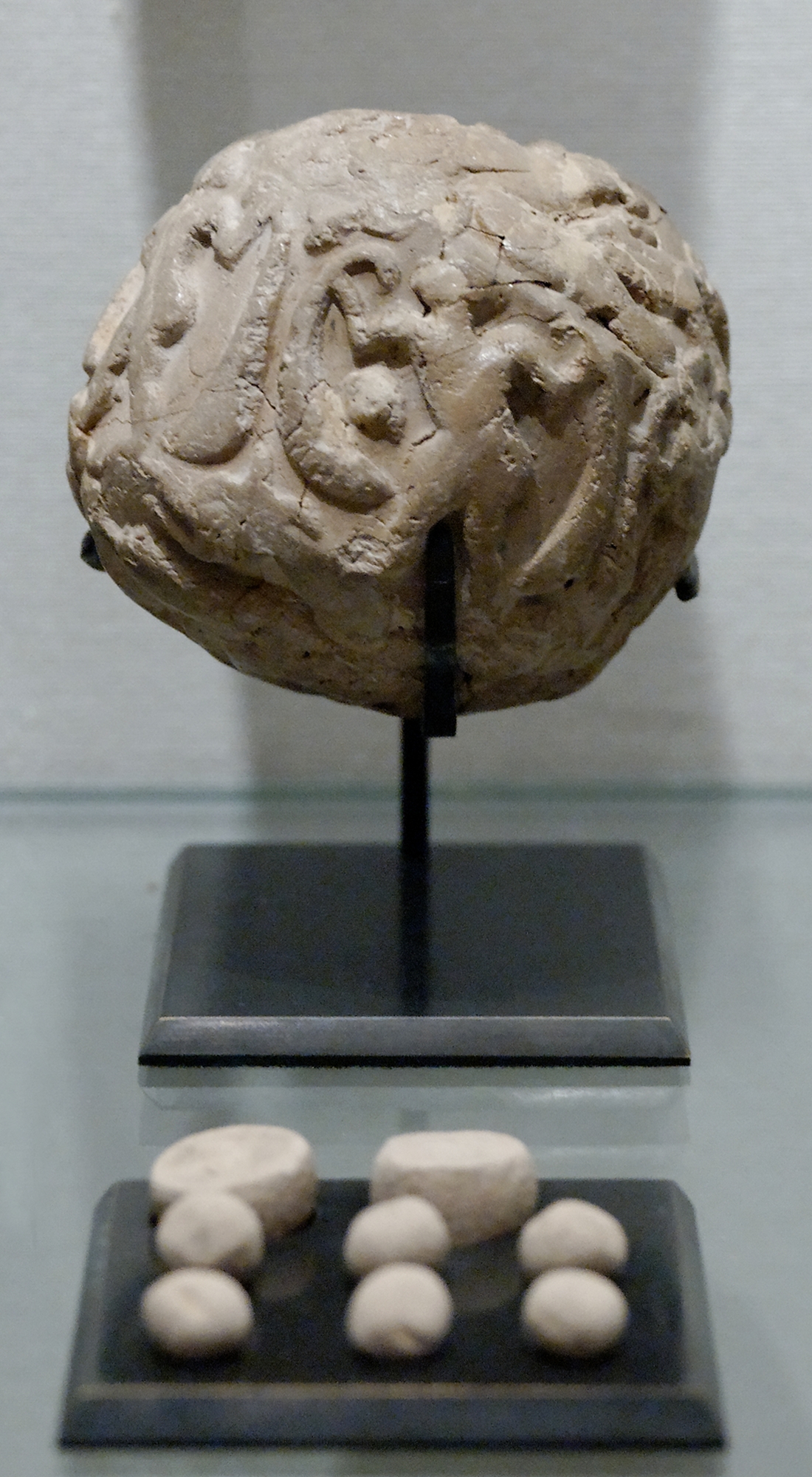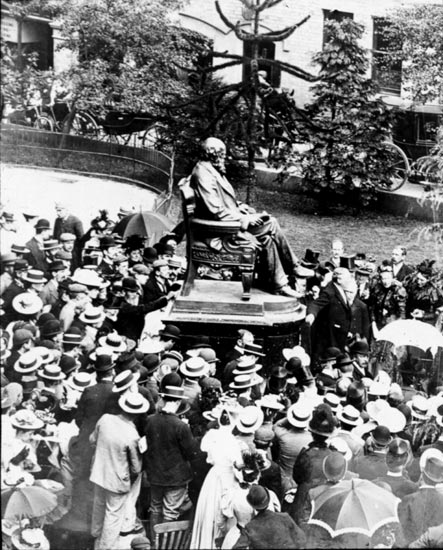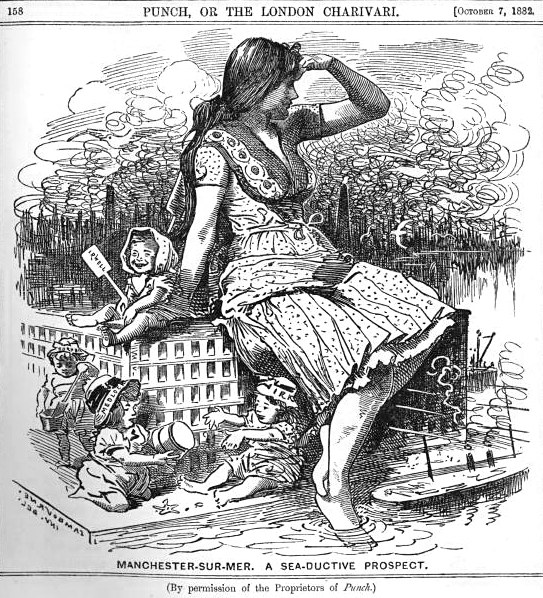|
Shropshire Bulla
The Shropshire bulla ("" is Medieval Latin for "a round seal", Classical Latin for "bubble, blob", plural bullae) is a Late Bronze Age gold pendant found by a metal detectorist in 2018 in Shropshire, England. Made primarily of gold, it is the eighth bulla discovered to date in Great Britain and Ireland, and only the second in Britain. The pendant, decorated with intricately carved geometric designs, is now in the British Museum in London. According to the Portable Antiquities Scheme, "The workmanship of the construction and decoration of the 'Shropshire Marches' bulla represents the highest skill and expertise seen within decorated metalwork of the period being almost un-paralleled within a British context." The findspot has been kept secret, called only the "Shropshire Marches", that is to say the west side of Shropshire, forming part of the Welsh Marches along the border with Wales. Description The Shropshire bulla is a D-shaped hollow object created from pieces of gold shee ... [...More Info...] [...Related Items...] OR: [Wikipedia] [Google] [Baidu] |
Gold Working In The Bronze Age British Isles
Gold working in the Bronze Age British Isles refers to the use of gold to produce ornaments and other prestige items in the British Isles during the Bronze Age, between circa 2500 and c.800 BCE in Britain, and up to about 550 BCE in Ireland. In this period, communities in Britain and Ireland first learned how to work metal, leading to the widespread creation of not only gold but also copper and bronze items as well. Gold artefacts in particular were prestige items used to designate the high status of those individuals who wore, or were buried with them. Around 1,500 gold objects dating to the Bronze Age survive in collections, around 1000 of them from Ireland and the other 500 from Britain; this is a much smaller number than would have been originally crafted, leading archaeologists to believe that "many thousands of gold objects were made and used" in the Bronze Age British Isles. Records indicate that Bronze Age gold artefacts had begun to be discovered by the 18th century at ... [...More Info...] [...Related Items...] OR: [Wikipedia] [Google] [Baidu] |
Bulla (seal)
A bulla (Medieval Latin for "a round seal", from Classical Latin ''bulla'', "bubble, blob"; plural bullae) is an inscribed clay or soft metal (such as lead or tin) or bitumen or wax token used in commercial and legal documentation as a form of authentication and for tamper-proofing whatever is attached to it (or, in the historical form, contained in it). In their oldest attested form, as used in the ancient Near East and the Middle East of the 8th millennium BC onwards, bullae were hollow clay balls that contained other smaller tokens that identified the quantity and types of goods being recorded. In this form, bullae represent one of the earliest forms of specialization in the ancient world, and likely required skill to create. From about the 4th millennium BC onwards, as communications on papyrus and parchment became widespread, bullae evolved into simpler tokens that were attached to the documents with cord, and impressed with a unique sign (i.e., a seal) to provide the same kin ... [...More Info...] [...Related Items...] OR: [Wikipedia] [Google] [Baidu] |
Welsh Marches
The Welsh Marches ( cy, Y Mers) is an imprecisely defined area along the border between England and Wales in the United Kingdom. The precise meaning of the term has varied at different periods. The English term Welsh March (in Medieval Latin ''Marchia Walliae'') was originally used in the Middle Ages to denote the marches between England and the Principality of Wales, in which Marcher lords had specific rights, exercised to some extent independently of the king of England. In modern usage, "the Marches" is often used to describe those English counties which lie along the border with Wales, particularly Shropshire and Herefordshire, and sometimes adjoining areas of Wales. However, at one time the Marches included all of the historic counties of Cheshire, Shropshire, Herefordshire, Worcestershire and Gloucestershire. In this context the word ''march'' means a border region or frontier, and is cognate with the verb "to march," both ultimately derived from Proto-Indo-European ' ... [...More Info...] [...Related Items...] OR: [Wikipedia] [Google] [Baidu] |
Gold Lunula
The Gold lunula (plural: lunulae) is a distinctive type of late Neolithic, Chalcolithic or (most often) early Bronze Age necklace or collar shaped like a crescent moon; most are from Prehistoric Ireland. They are normally flat and thin, with roundish spatulate terminals that are often twisted to 45 to 90 degrees from the plane of the body. Gold lunulae fall into three distinct groups, termed Classical, Unaccomplished and Provincial by archaeologists. Most have been found in Ireland, but there are moderate numbers in other parts of Europe as well, from Great Britain to areas of the continent fairly near the Atlantic coasts. Although no lunula has been directly dated, from associations with other artefacts it is thought they were being made sometime in the period between 2400–2000 BC; a wooden box associated with one Irish find has recently given a radiocarbon dating range of 2460–2040 BC. Of the more than a hundred gold lunulae known from Western Europe, more than eighty ... [...More Info...] [...Related Items...] OR: [Wikipedia] [Google] [Baidu] |
Torc
A torc, also spelled torq or torque, is a large rigid or stiff neck ring in metal, made either as a single piece or from strands twisted together. The great majority are open at the front, although some had hook and ring closures and a few had mortice and tenon locking catches to close them. Many seem designed for near-permanent wear and would have been difficult to remove. Torcs are found in the Scythian, Illyrian, Thracian, Celtic, and other cultures of the European Iron Age from around the 8th century BC to the 3rd century AD. For the Iron Age Celts, the gold torc seems to have been a key object. It identifies the wearer as a person of high rank, and many of the finest works of ancient Celtic art are torcs. The Celtic torc disappears in the Migration Period, but during the Viking Age torc-style metal necklaces, now mainly in silver, came back into fashion. Torc styles of neck-ring are found as part of the jewellery styles of various other cultures and periods. Te ... [...More Info...] [...Related Items...] OR: [Wikipedia] [Google] [Baidu] |
Shrewsbury Museum And Art Gallery
Shrewsbury Museum and Art Gallery was founded in 1835 as the Museum of the Shropshire and North Wales Natural History and Antiquarian Society Society in Dogpole, Shrewsbury, England. In 1853 the collections were moved to Vaughan's Mansion on College Hill, which became known as the Shropshire and North Wales Museum. After 160 years and two subsequent homes the museum returned to Vaughan's Mansion and the Music Hall Complex after a major redevelopment of the site. History The Shrewsbury Museum and Art Gallery was founded in 1835 as the Museum of the Shropshire and North Wales Natural History and Antiquarian Society Society in Dogpole, Shrewsbury. In 1853 the collections were moved to Vaughan's Mansion on College Hill, which became known as the Shropshire and North Wales Museum. In 1877 the Society merged with newly formed Shropshire Archaeological Society to become Shropshire Archaeological and Natural History Society. That year the museum accepted a major collection of finds rec ... [...More Info...] [...Related Items...] OR: [Wikipedia] [Google] [Baidu] |
The British Museum Friends
The British Museum Friends (BMF) is a registered charitable organisation in the UK with close links to the British Museum, and was set up in 1968. It provides funding in the form of grants to the British Museum in order to support the educational objectives of the Museum including to allow the Museum to acquire new items and collections, and assists with financing research programmes, conservation, and new technologies throughout the Museum. Acquisitions Acquisitions supported by the BMF include the Nimrud Ivories, the Warren Cup, the Canterbury Astrolabe Quadrant, the Burney Relief, a Mycenaean terracotta group of three dancers in a ring, the gold mancus of Coenwulf, the Ringlemere Cup, the Vale of York Hoard and two very rare gold coins of the Roman Emperor Carausius found in the North Midlands in 2007. Other acquisitions funded in whole or in part by the Friends during 2008–9 include the Chettle Park Hoard and twelve Greek papyri from Roman Egypt from the Oxyr ... [...More Info...] [...Related Items...] OR: [Wikipedia] [Google] [Baidu] |
Art Fund
Art Fund (formerly the National Art Collections Fund) is an independent membership-based British charity, which raises funds to aid the acquisition of artworks for the nation. It gives grants and acts as a channel for many gifts and bequests, as well as lobbying on behalf of museums and galleries and their users. It relies on members' subscriptions and public donations for funds and does not receive funding from the government or the National Lottery. Since its foundation in 1903 the Fund has been involved in the acquisition of over 860,000 works of art of every kind, including many of the most famous objects in British public collections, such as Velázquez's ''Rokeby Venus'' in the National Gallery, Picasso's '' Weeping Woman'' in the Tate collection, the Anglo-Saxon Staffordshire Hoard in Birmingham Museum and Art Gallery and the medieval Canterbury Astrolabe Quadrant in the British Museum. History The original idea for an arts charity can be traced to a lecture given by J ... [...More Info...] [...Related Items...] OR: [Wikipedia] [Google] [Baidu] |
Manchester Ship Canal
The Manchester Ship Canal is a inland waterway in the North West of England linking Manchester to the Irish Sea. Starting at the Mersey Estuary at Eastham, near Ellesmere Port, Cheshire, it generally follows the original routes of the rivers Mersey and Irwell through the historic counties of Cheshire and Lancashire. Several sets of locks lift vessels about to the canal's terminus in Manchester. Landmarks along its route include the Barton Swing Aqueduct, the world's only swing aqueduct, and Trafford Park, the world's first planned industrial estate and still the largest in Europe. The rivers Mersey and Irwell were first made navigable in the early 18th century. Goods were also transported on the Runcorn extension of the Bridgewater Canal (from 1776) and the Liverpool and Manchester Railway (from 1830), but by the late 19th century the Mersey and Irwell Navigation had fallen into disrepair and was often unusable. In addition, Manchester's business community viewed the cha ... [...More Info...] [...Related Items...] OR: [Wikipedia] [Google] [Baidu] |
Finds Liaison Officer
The Portable Antiquities Scheme (PAS) is a voluntary programme run by the United Kingdom government to record the increasing numbers of small finds of archaeological interest found by members of the public. The scheme begun in 1997 and now covers most of England and Wales. It is primarily focused on private metal detectorists who through their hobby regularly discover artefacts that would otherwise go unrecorded. Members of the public can also report objects they have found and finds of non-metallic objects are also covered by the scheme. Finds that legally constitute treasure are dealt with through the Treasure Act 1996. This however concentrates on precious metals, prehistoric base metal, and finds in association with them. Non-prehistoric base metal and non-metal finds would not be recognised as treasure and therefore be unrecorded. The PAS exists to fill this gap. The scheme funds the posts of Finds Liaison Officers (FLOs) at county councils or local museums to whom finders ca ... [...More Info...] [...Related Items...] OR: [Wikipedia] [Google] [Baidu] |
Classical Antiquity
Classical antiquity (also the classical era, classical period or classical age) is the period of cultural history between the 8th century BC and the 5th century AD centred on the Mediterranean Sea, comprising the interlocking civilizations of ancient Greece and ancient Rome known as the Greco-Roman world. It is the period in which both Greek and Roman societies flourished and wielded huge influence throughout much of Europe, North Africa, and Western Asia. Conventionally, it is taken to begin with the earliest-recorded Epic Greek poetry of Homer (8th–7th-century BC), and continues through the emergence of Christianity (1st century AD) and the fall of the Western Roman Empire (5th-century AD). It ends with the decline of classical culture during late antiquity (250–750), a period overlapping with the Early Middle Ages (600–1000). Such a wide span of history and territory covers many disparate cultures and periods. ''Classical antiquity'' may also refer to an idealized v ... [...More Info...] [...Related Items...] OR: [Wikipedia] [Google] [Baidu] |
.jpg)






.jpg)